Open-Celled Foams of Polyethersulfone/Poly(N-vinylpyrrolidone) Blends for Ultrafiltration Applications
Abstract
1. Introduction
2. Materials
3. Experimental and Methodology
3.1. Material Characterization
3.2. Batch Foaming
3.3. Membrane Manufacturing
3.4. Foam Characterization and Membrane Properties
4. Results and Discussion
4.1. Material Characterization
4.2. Batch Foaming
4.3. Membranes
5. Conclusions
Supplementary Materials
Author Contributions
Funding
Institutional Review Board Statement
Informed Consent Statement
Data Availability Statement
Acknowledgments
Conflicts of Interest
Abbreviation
| Symbol | Parameter | Unit |
| Tg | Glass transition temperature of the blend | K |
| wI | Mass fraction of polymer I | - |
| cp,I | Heat capacity of polymer I | mW |
| Tg,I | Glass transition temperature of polymer I | K |
| WII | Mass fraction of polymer II | - |
| cp,II | Heat capacity of polymer II | mW |
| Tg,II | Glass transition temperature of polymer II | K |
| Horizontal shift factor | - | |
| WLF parameters | K | |
| Temperature | °C | |
| Reference temperature | °C | |
| Retention coefficient | - | |
| Mass fraction of PEO in permeate | - | |
| Mass fraction of PEO in feed | - |
References
- Zhao, Y. Chapter 2—Physical and chemical treatment processes for leachate. In Pollution Control Technology for Leachate from Municipal Solid Waste; Youcai, Z., Ed.; Butterworth-Heinemann: Oxford, UK, 2018; pp. 31–183. [Google Scholar] [CrossRef]
- Singh, R. Chapter 1—Introduction to Membrane Technology. In Membrane Technology and Engineering for Water Purification, 2nd ed.; Butterworth-Heinemann: Oxford, UK, 2015; pp. 1–80. [Google Scholar] [CrossRef]
- Zhang, F. Preparation of cation exchange resin filled EVAL hollow fiber membrane adsorbent. Int. J. Chem. 2009, 1, 87–90. [Google Scholar] [CrossRef]
- Verissimo, S.; Peinemann, K.V.; Bordado, J. Thin-film composite hollow fiber membranes: An optimized manufacturing method. J. Membr. Sci. 2005, 264, 48–55. [Google Scholar] [CrossRef]
- Wang, D.L.; Teo, W.K.; Li, K. Preparation and characterization of high-flux polysulfone hollow fibre gas separation membranes. J. Membr. Sci. 2002, 204, 247–256. [Google Scholar] [CrossRef]
- Bulte, A.M.W.; Mulder, M.H.V.; Smolders, C.A.; Strathmann, H. Diffusion induced phase separation with crystallizable nylons. 1. Mass transfer processes for nylon 4,6. J. Membr. Sci. 1996, 121, 37–49. [Google Scholar] [CrossRef]
- Bulte, A.M.W.; Mulder, M.H.V.; Smolders, C.A.; Strathmann, H. Diffusion induced phase separation with crystallizable nylons. 2. Relation to final membrane morphology. J. Membr. Sci. 1996, 121, 51–58. [Google Scholar] [CrossRef]
- Preventing Adverse Health Effects from Exposure to: Dimethylformamide (DMF). Available online: https://www.cdc.gov/niosh/docs/90-105/default.html (accessed on 13 February 2022).
- Åkesson, D.B. N-Methyl-2-pyrrolidone. Available online: https://www.who.int/ipcs/publications/cicad/en/cicad35.pdf (accessed on 13 February 2022).
- Dimethyl Acetamide. Available online: https://nj.gov/health/eoh/rtkweb/documents/fs/0736.pdf (accessed on 13 February 2022).
- ECHA, E.C.A. Formic Acid. Available online: https://echa.europa.eu/de/substance-information/-/substanceinfo/100.000.527 (accessed on 13 February 2022).
- Redlich, C.A.; Beckett, W.S.; Sparer, J.; Barwick, K.W.; Riely, C.A.; Miller, H.; Sigal, S.L.; Shalat, S.L.; Cullen, M.R. Liver-disease associated with occupational exposure to the solvent dimethylformamide. Ann. Intern. Med. 1988, 108, 680–686. [Google Scholar] [CrossRef] [PubMed]
- Rundquist, E.M.; Pink, C.J.; Livingston, A.G. Organic solvent nanofiltration: A potential alternative to distillation for solvent recovery from crystallisation mother liquors. Green Chem. 2012, 14, 2197–2205. [Google Scholar] [CrossRef]
- Perry, R.H.; Green, D.W.; Maloney, J.O. Distillation. In Perry’s Chemical Engineers’ Handbook, 7th ed.; McGraw-Hill: New York, NY, USA, 1997. [Google Scholar]
- Gadalla, M.A.; Olujic, Z.; Jansens, P.J.; Jobson, M.; Smith, R. Reducing CO2 emissions and energy consumption of heat-integrated distillation systems. Environ. Sci. Technol. 2005, 39, 6860–6870. [Google Scholar] [CrossRef]
- Okolieocha, C.; Raps, D.; Subramaniam, K.; Altstädt, V. Microcellular to nanocellular polymer foams: Progress (2004–2015) and future directions—A review. Eur. Polym. J. 2015, 73, 500–519. [Google Scholar] [CrossRef]
- Krause, B.; Boerrigter, M.E.; van der Vegt, N.F.A.; Strathmann, H.; Wessling, M. Novel open-cellular polysulfone morphologies produced with trace concentrations of solvents as pore opener. J. Membr. Sci. 2001, 187, 181–192. [Google Scholar] [CrossRef]
- Krause, B.; van der Vegt, N.F.A.; Wessling, M. New ways to produce porous polymeric membranes by carbon dioxide foaming. Desalination 2002, 144, 5–7. [Google Scholar] [CrossRef]
- Gong, P.J.; Taniguchi, T.; Ohshima, M. Nanoporous structure of the cell walls of polycarbonate foams. J. Mater. Sci. 2014, 49, 2605–2617. [Google Scholar] [CrossRef]
- Sorrentino, L.; Aurilia, M.; Iannace, S. Polymeric Foams from High-Performance Thermoplastics. Adv. Polym. Technol. 2011, 30, 234–243. [Google Scholar] [CrossRef]
- Guo, H.M.; Nicolae, A.; Kumar, V. Solid-state microcellular and nanocellular polysulfone foams. J. Polym. Sci. Pol. Phys. 2015, 53, 975–985. [Google Scholar] [CrossRef]
- Guo, H.M.; Nicolae, A.; Kumar, V. Fabrication of high temperature polyphenylsulfone nanofoams using high pressure liquid carbon dioxide. Cell Polym. 2016, 35, 119–142. [Google Scholar] [CrossRef]
- Guo, H.M.; Kumar, V. Effect of glass transition temperature and saturation temperature on the solid-state microcellular foaming of cyclic olefin copolymer. J. Appl. Polym. Sci. 2015, 132, 42226. [Google Scholar] [CrossRef]
- Li, Z.K.; Jia, Y.B.; Bai, S.B. Polysulfone foam with high expansion ratio prepared by supercritical carbon dioxide assisted molding foaming method. RSC Adv. 2018, 8, 2880–2886. [Google Scholar] [CrossRef]
- Hwang, Y.D.; Cha, S.W. The relationship between gas absorption and the glass transition temperature in a batch microcellular foaming process. Polym. Test. 2002, 21, 269–275. [Google Scholar] [CrossRef]
- Sauceau, M.; Fages, J.; Common, A.; Nikitine, C.; Rodier, E. New challenges in polymer foaming: A review of extrusion processes assisted by supercritical carbon dioxide. Prog. Polym. Sci. 2011, 36, 749–766. [Google Scholar] [CrossRef]
- Jacobs, L.J.M. Carbon Dioxide as a Sustainable Means to Control Polymer Foam Morphology. Ph.D. Thesis, Technische Universiteit Eindhoven, Eindhoven, The Netherlands, 2008. [Google Scholar]
- Hu, D.D.; Gu, Y.; Liu, T.; Zhao, L. Microcellular foaming of polysulfones in supercritical CO2 and the effect of co-blowing agent. J. Supercrit. Fluid 2018, 140, 21–31. [Google Scholar] [CrossRef]
- Owusu-Nkwantabisah, S.; Staudt, C.; Lesser, A.J. Synergy of supercritical CO2 and superheated H2O for enhanced processability of polyethersulfone towards open cell foams. Polym. Eng. Sci. 2018, 58, 1108–1114. [Google Scholar] [CrossRef]
- Schulze, M.; Handge, U.A.; Abetz, V. Preparation and characterisation of open-celled foams using polystyrene-b-poly(4-vinylpyridine) and poly(4-methylstyrene)-b-poly(4-vinylpyridine) diblock copolymers. Polymer 2017, 108, 400–412. [Google Scholar] [CrossRef]
- Smith, R.M. Extractions with superheated water. J. Chromatogr. A 2002, 975, 31–46. [Google Scholar] [CrossRef]
- Tsehaye, M.T.; Velizarov, S.; Van der Bruggen, B. Stability of polyethersulfone membranes to oxidative agents: A review. Polym. Degrad. Stabil. 2018, 157, 15–33. [Google Scholar] [CrossRef]
- Grunig, L.; Handge, U.A.; Koll, J.; Gronwald, O.; Weber, M.; Hankiewicz, B.; Scharnagl, N.; Abetz, V. Hydrophilic dual layer hollow fiber membranes for ultrafiltration. Membranes 2020, 10, 143. [Google Scholar] [CrossRef]
- Jaleh, B.; Zare, E.; Azizian, S.; Qanati, O.; Nasrollahzadeh, M.; Varma, R.S. Preparation and Characterization of Polyvinylpyrrolidone/Polysulfone Ultrafiltration Membrane Modified by Graphene Oxide and Titanium Dioxide for Enhancing Hydrophilicity and Antifouling Properties. J. Inorg. Organomet. Polym. Mater. 2020, 30, 2213–2223. [Google Scholar] [CrossRef]
- Dibrov, G.; Kagramanov, G.; Sudin, V.; Grushevenko, E.; Yushkin, A.; Volkov, A. Influence of sodium hypochlorite treatment on pore size distribution of polysulfone/polyvinylpyrrolidone membranes. Membranes 2020, 10, 356. [Google Scholar] [CrossRef]
- Al Malek, S.A.; Abu Seman, M.N.; Johnson, D.; Hilal, N. Formation and characterization of polyethersulfone membranes using different concentrations of polyvinylpyrrolidone. Desalination 2012, 288, 31–39. [Google Scholar] [CrossRef]
- Zhang, J.; Chen, S.; Bai, H.J.; Lu, S.F.; Xiang, Y.; Jiang, S.P. Effects of phosphotungstic acid on performance of phosphoric acid doped polyethersulfone-polyvinylpyrrolidone membranes for high temperature fuel cells. Int. J. Hydrogen Energy 2021, 46, 11104–11114. [Google Scholar] [CrossRef]
- Dai, Y.; Wang, J.; Tao, P.P.; He, R.H. Various hydrophilic carbon dots doped high temperature proton exchange composite membranes based on polyvinylpyrrolidone and polyethersulfone. J. Colloid Interf. Sci. 2019, 553, 503–511. [Google Scholar] [CrossRef]
- Gronwald, O.; Weber, M. AGNIQUE AMD 3L as green solvent for polyethersulfone ultrafiltration membrane preparation. J. Appl. Polym. Sci. 2020, 137, 48419. [Google Scholar] [CrossRef]
- Aili, D.; Kraglund, M.R.; Tavacoli, J.; Chatzichristodoulou, C.; Jensen, J.O. Polysulfone-polyvinylpyrrolidone blend membranes as electrolytes in alkaline water electrolysis. J. Membr. Sci. 2020, 598, 117674. [Google Scholar] [CrossRef]
- Shi, Z.L.; Ma, X.W.; Zhao, G.Q.; Wang, G.L.; Zhang, L.; Li, B. Fabrication of high porosity Nanocellular polymer foams based on PMMA/PVDF blends. Mater. Des. 2020, 195, 109002. [Google Scholar] [CrossRef]
- Costeux, S.; Khan, I.; Bunker, S.P.; Jeon, H.K. Experimental study and modeling of nanofoams formation from single phase acrylic copolymers. J. Cell. Plast. 2015, 51, 197–221. [Google Scholar] [CrossRef]
- Sun, H.L.; Sur, G.S.; Mark, J.E. Microcellular foams from polyethersulfone and polyphenylsulfone—Preparation and mechanical properties. Eur. Polym. J. 2002, 38, 2373–2381. [Google Scholar] [CrossRef]
- Xie, Y.P.; Ye, F.; Chen, W.H.; Tang, J.H.; Liu, P.J. Preparation of high-strength and lightweight microcellular polysulfone foam with a segregated CNT network for excellent electromagnetic shielding. RSC Adv. 2020, 10, 11994–12003. [Google Scholar] [CrossRef]
- Abbasi, H.; Antunes, M.; Velasco, J.I. Effects of graphene nanoplatelets and cellular structure on the thermal conductivity of polysulfone nanocomposite foams. Polymers 2020, 12, 25. [Google Scholar] [CrossRef]
- Antunes, M.; Abbasi, H.; Velasco, J.I. The effect of microcellular structure on the dynamic mechanical thermal properties of high-performance nanocomposite foams made of graphene nanoplatelets-filled polysulfone. Polymers 2021, 13, 437. [Google Scholar] [CrossRef]
- Abbasi, H.; Antunes, M.; Velasco, J.I. Electrical conduction behavior of high-performance microcellular nanocomposites made of graphene nanoplatelet-filled polysulfone. Nanomaterials 2020, 10, 2425. [Google Scholar] [CrossRef]
- Lu, Y.Q.; Li, S.Y.; Chen, F.Y.; Ma, H.; Gao, C.J.; Xue, L.X. Development of coin-shaped ZIF-7 functionalized superhydrophobic polysulfone composite foams for continuous removal of oily contaminants from water. J. Hazard. Mater. 2022, 421, 126788. [Google Scholar] [CrossRef]
- Liu, S.Q.; Yin, S.; Duvigneau, J.; Vancso, G.J. Bubble seeding nanocavities: Multiple polymer foam cell nucleation by polydimethylsiloxane-grafted designer silica nanoparticles. ACS Nano 2020, 14, 1623–1634. [Google Scholar] [CrossRef]
- Ismail, A.F.; Mustaffar, M.I.; Illias, R.M.; Abdullah, M.S. Effect of dope extrusion rate on morphology and performance of hollow fibers membrane for ultrafiltration. Sep. Purif. Technol. 2006, 49, 10–19. [Google Scholar] [CrossRef]
- Jim, J.S.; Chang, C.W.; Zhu, J.; Wu, H.; Zhang, Z.T. Solubility of poly(vinylpyrrolidone) with different molecular weights in supercritical carbon dioxide. J. Chem. Eng. Data 2015, 60, 3397–3403. [Google Scholar] [CrossRef]
- Couchman, P.R. Compositional variation of glass-transition temperatures. 2. Application of thermodynamic theory to compatible polymer blends. Macromolecules 1978, 11, 1156–1161. [Google Scholar] [CrossRef]
- Fox, T.G. Influence of diluent and of copolymer composition on the glass temperature of a polymer system. Bull. Am. Phys. Soc. 1956, 1, 123. [Google Scholar]
- Kargar, M.; Handge, U.A. Numerical simulations of gas sorption experiments in polymers: Influence of aspect ratio and pressure increase rate on the determination of diffusion coefficient. Macromol. Theory Simul. 2021, 30, 2100016. [Google Scholar] [CrossRef]
- Sun, H.L.; Mark, E.J. Preparation, characterization, and mechanical properties of some microcellular polysulfone foams. J. Appl. Polym. Sci. 2002, 86, 1692–1701. [Google Scholar] [CrossRef]
- Honerkamp, J.; Weese, J. A note on estimating mastercurves. Rheol. Acta 1993, 32, 57–64. [Google Scholar] [CrossRef]
- Ferry, J.D. Viscoelastic Properties of Polymers, 3rd ed.; Wiley: New York, NY, USA, 1980. [Google Scholar]
- Lee, J. Intrinsic adhesion properties of poly(vinyl pyrrolidone) to pharmaceutical materials: Humidity effect. Macromol. Biosci. 2005, 5, 1085–1093. [Google Scholar] [CrossRef]
- Maeda, Y.; Paul, D.R. Effect of antiplasticization on gas sorption and transport. 1. polysulfone. J. Polym. Sci. Pol. Phys. 1987, 25, 957–980. [Google Scholar] [CrossRef]
- Maeda, Y.; Paul, D.R. Effect of antiplasticization on gas sorption and transport. 3. free-volume interpretation. J. Polym. Sci. Pol. Phys. 1987, 25, 1005–1016. [Google Scholar] [CrossRef]
- Hiremath, P.; Nuguru, K.; Agrahari, V. Chapter 8—Material attributes and their impact on wet granulation process performance. In Handbook of Pharmaceutical Wet Granulation; Narang, A.S., Badawy, S.I.F., Eds.; Academic Press: Cambridge, MA, USA, 2019; pp. 263–315. [Google Scholar] [CrossRef]
- McKeen, L.W. 4-Binders. In Fluorinated Coatings and Finishes Handbook; McKeen, L.W., Ed.; William Andrew Publishing: Norwich, NY, USA, 2006; pp. 45–58. [Google Scholar] [CrossRef]
- Haenelt, T.G.; Georgopanos, P.; Abetz, C.; Rangou, S.; Alisch, D.; Meyer, A.; Handge, U.A.; Abetz, V. Morphology and elasticity of polystyrene-block-polyisoprene diblock copolymers in the melt. Korea-Aust. Rheol. J. 2014, 26, 263–275. [Google Scholar] [CrossRef]
- Georgopanos, P.; Rangou, S.; Haenelt, T.G.; Abetz, C.; Meyer, A.; Filiz, V.; Handge, U.A.; Abetz, V. Analysis of glass transition and relaxation processes of low molecular weight polystyrene-b-polyisoprene diblock copolymers. Colloid Polym. Sci. 2014, 292, 1877–1891. [Google Scholar] [CrossRef][Green Version]
- Fukasawa, Y.; Chen, J.; Saito, H. A novel nanoporous structure on the surface of bubbles in polycarbonate foams. J. Polym. Sci. Pol. Phys. 2008, 46, 843–846. [Google Scholar] [CrossRef]
- Hliavitskaya, T.; Plisko, T.; Bildyukevich, A.; Lipnizki, F.; Rodrigues, G.; Sjolin, M. Modification of PES ultrafiltration membranes by cationic polyelectrolyte Praestol 859: Characterization, performance and application for purification of hemicellulose. Chem. Eng. Res. Des. 2020, 162, 187–199. [Google Scholar] [CrossRef]
- Kim, D.; Vovusha, H.; Schwingenschlogl, U.; Nunes, S.P. Polyethersulfone flat sheet and hollow fiber membranes from solutions in ionic liquids. J. Membr. Sci. 2017, 539, 161–171. [Google Scholar] [CrossRef]
- Fang, X.F.; Li, J.S.; Li, X.; Pan, S.L.; Zhang, X.; Sun, X.Y.; Shen, J.Y.; Han, W.Q.; Wang, L.J. Internal pore decoration with polydopamine nanoparticle on polymeric ultrafiltration membrane for enhanced heavy metal removal. Chem. Eng. J. 2017, 314, 38–49. [Google Scholar] [CrossRef]
- Lee, E.K.; Koros, W.J. Membranes, Synthetic, Applications. In Encyclopedia of Physical Science and Technology, 3rd ed.; Meyers, R.A., Ed.; Academic Press: New York, NY, USA, 2003; pp. 279–344. [Google Scholar]
- Adamczak, M.; Kaminska, G.; Bohdziewicz, J. Relationship between the addition of carbon nanotubes and cut-off of ultrafiltration membranes and their effect on retention of microcontaminants. Desalination Water Treat. 2021, 214, 263–272. [Google Scholar] [CrossRef]
- Mantel, T.; Benne, P.; Parsin, S.; Ernst, M. Electro-conductive composite gold-polyethersulfone-ultrafiltration-membrane: Characterization of membrane and natural organic matter (NOM) filtration performance at different in-situ applied surface potentials. Membranes 2018, 8, 64. [Google Scholar] [CrossRef]
- Fang, X.F.; Li, J.S.; Li, X.; Sun, X.Y.; Shen, J.Y.; Han, W.Q.; Wang, L.J. Polyethyleneimine, an effective additive for polyethersulfone ultrafiltration membrane with enhanced permeability and selectivity. J. Membr. Sci. 2015, 476, 216–223. [Google Scholar] [CrossRef]
- Gronwald, O.; Frost, I.; Ulbricht, M.; Shalmani, A.K.; Panglisch, S.; Grunig, L.; Handge, U.A.; Abetz, V.; Heijnen, M.; Weber, M. Hydrophilic poly(phenylene sulfone) membranes for ultrafiltration. Sep. Purif. Technol. 2020, 250, 117107. [Google Scholar] [CrossRef]





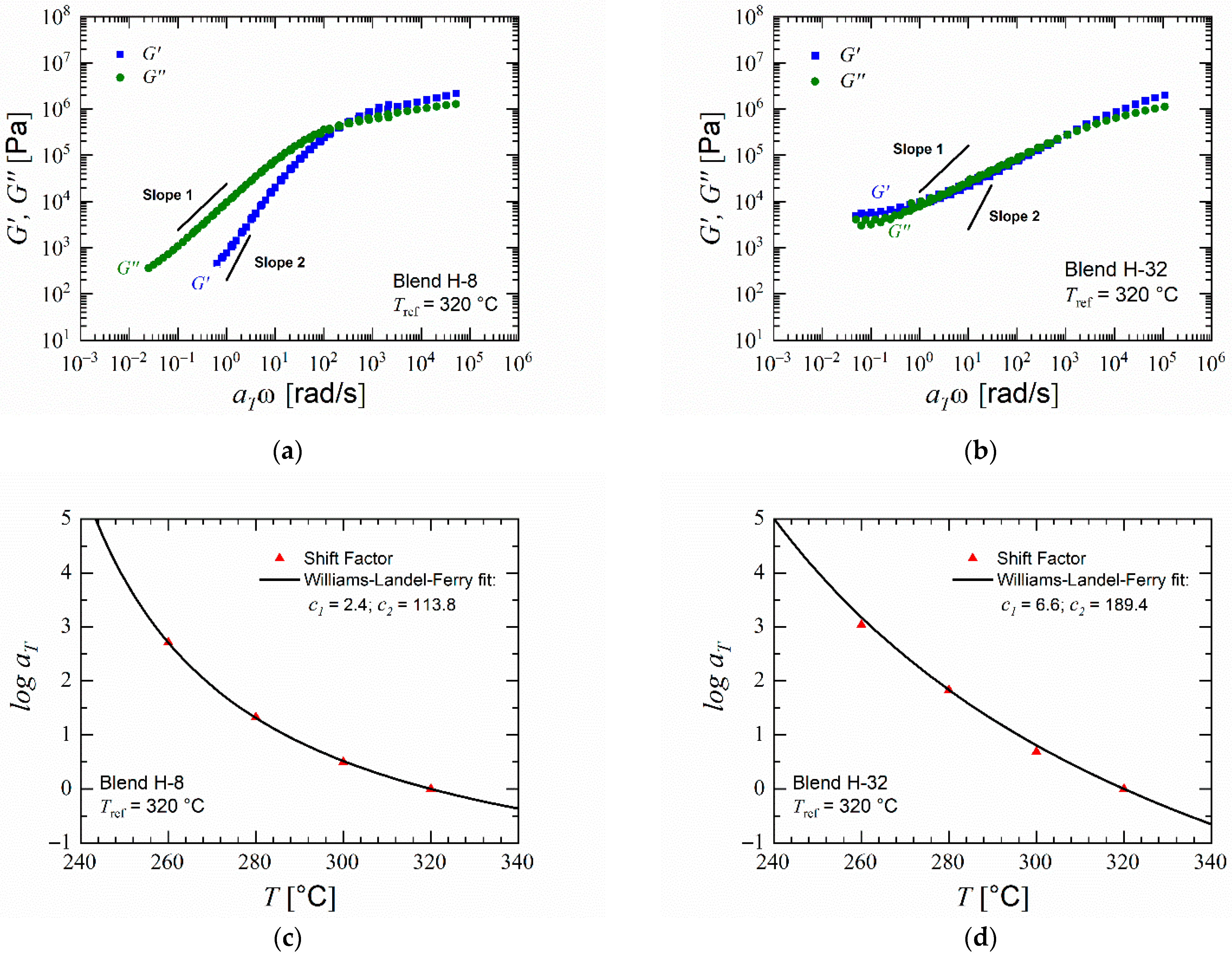


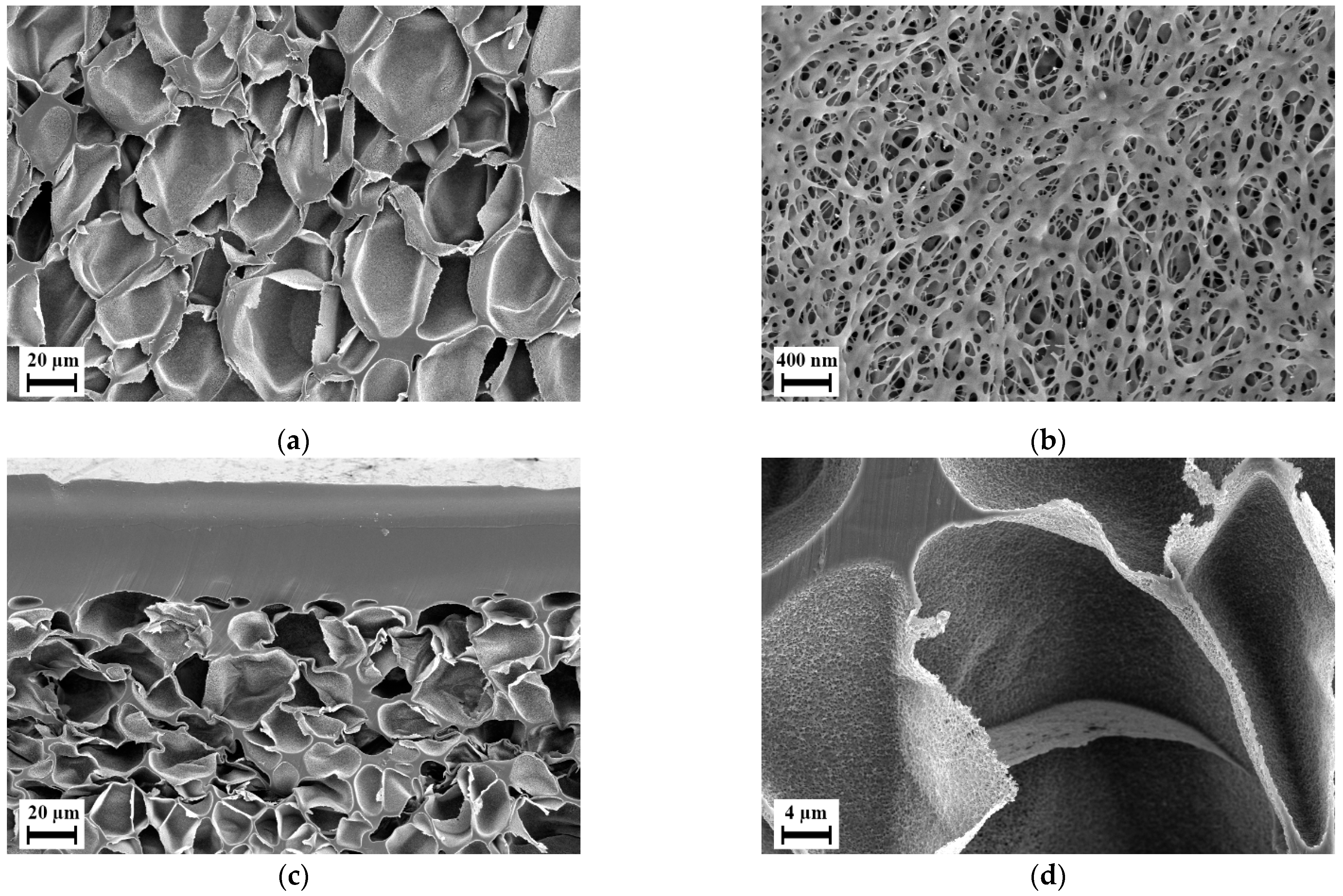
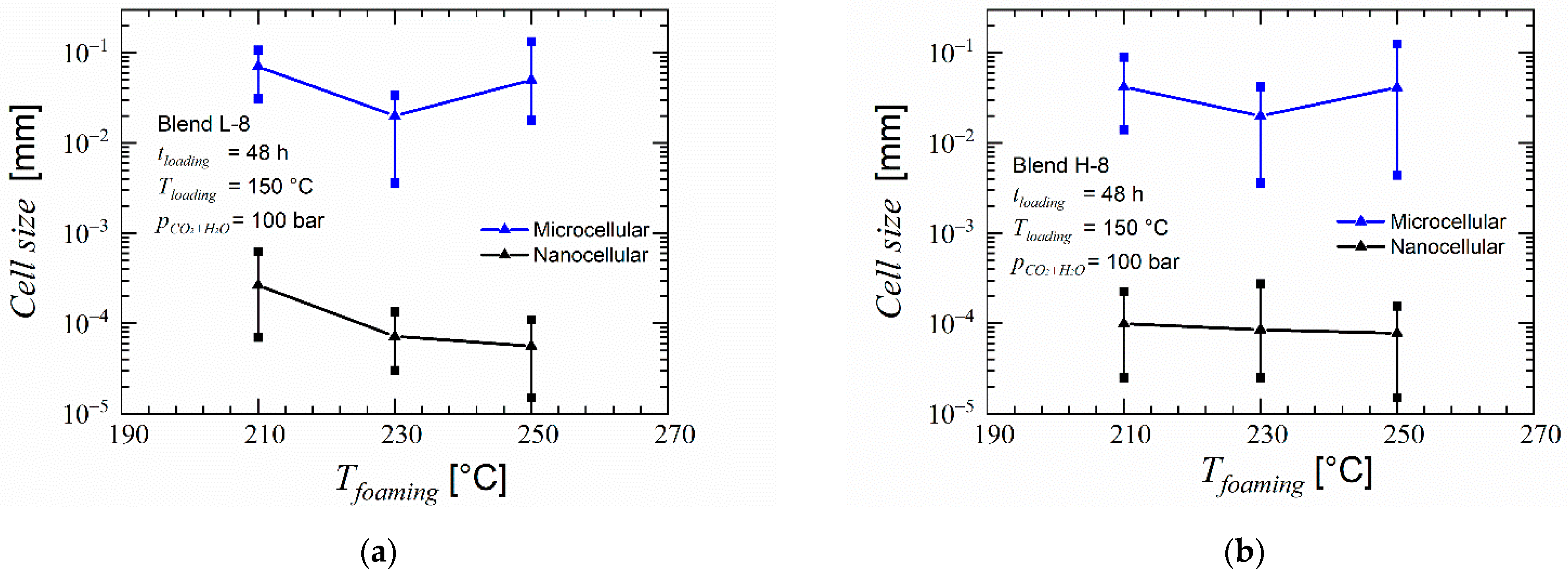


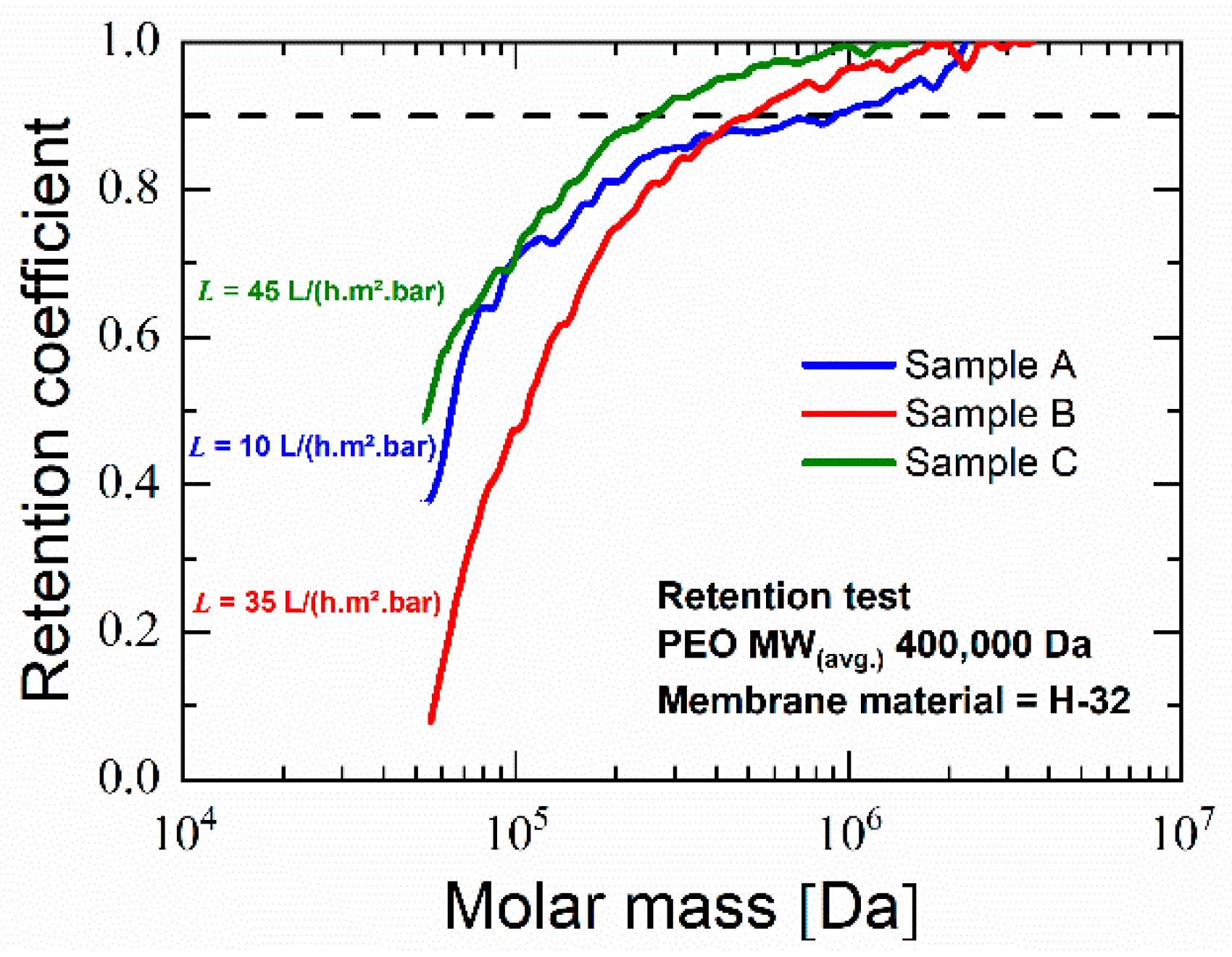
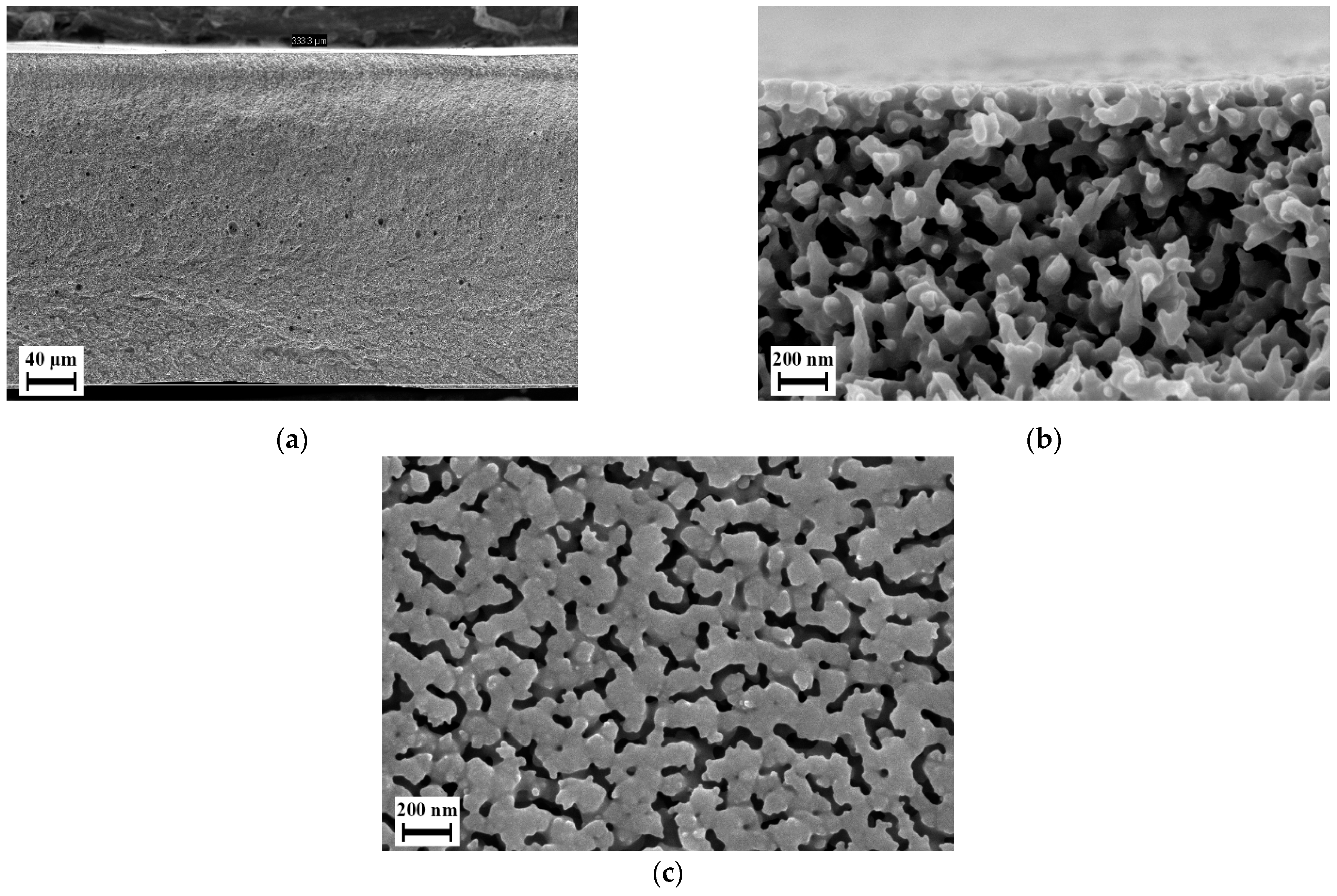
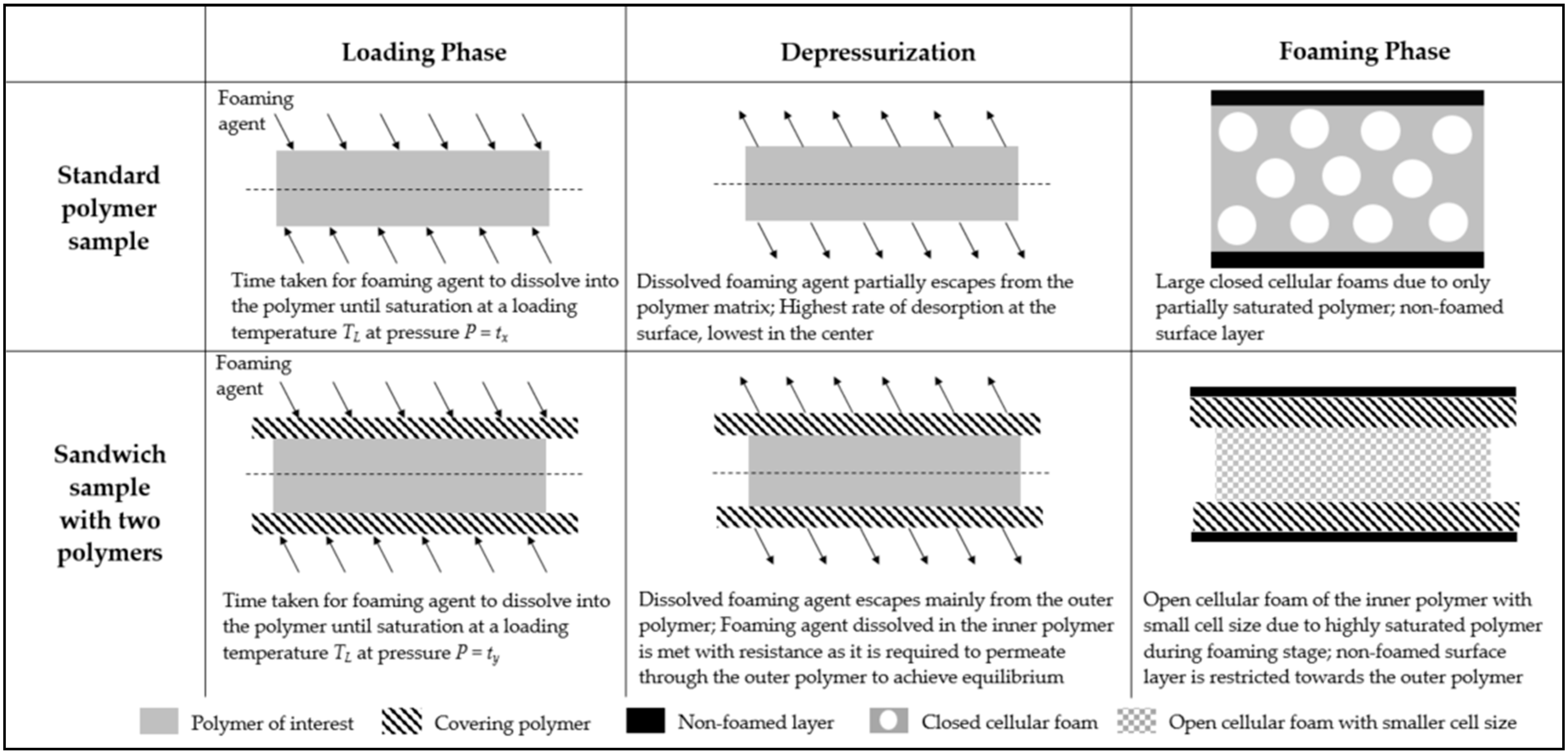
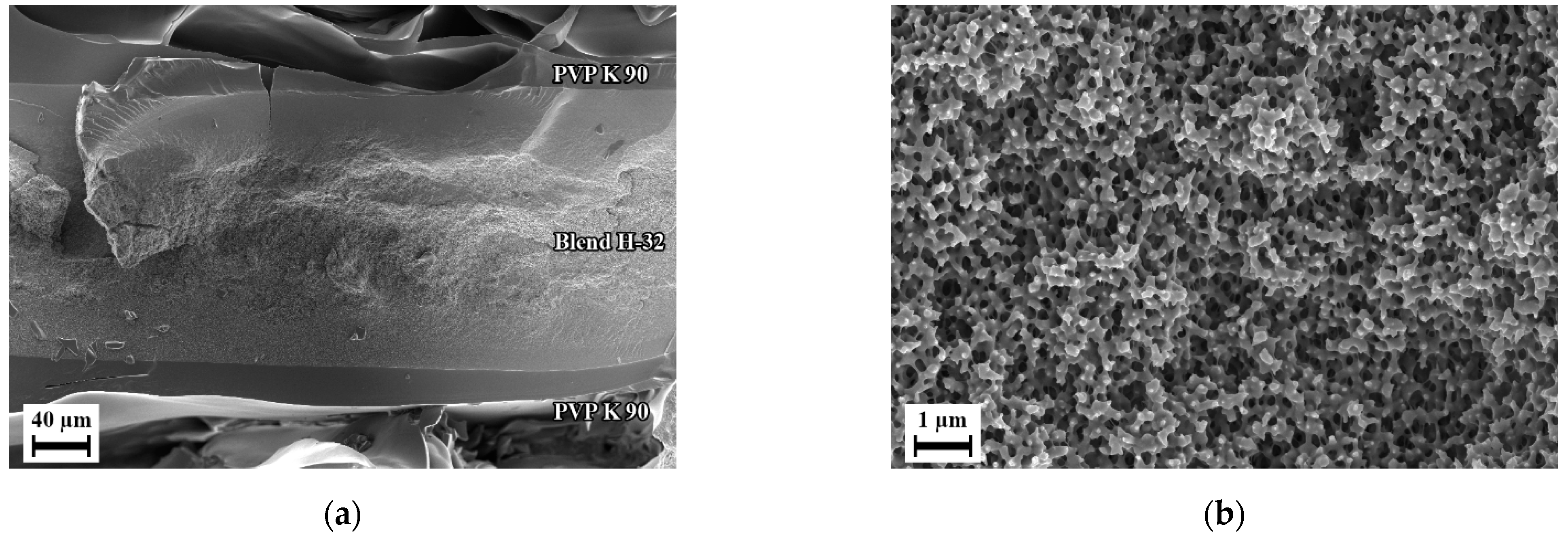
| Blend Name | PESU | PVP K 30 | |
|---|---|---|---|
| Type | Content [wt%] | Content [wt%] | |
| L-8 | PESU E 2010 | 92 | 8 |
| L-16 | PESU E 2010 | 84 | 16 |
| L-24 | PESU E 2010 | 76 | 24 |
| L-32 | PESU E 2010 | 68 | 32 |
| H-8 | PESU E 3020 P | 92 | 8 |
| H-16 | PESU E 3020 P | 84 | 16 |
| H-24 | PESU E 3020 P | 76 | 24 |
| H-32 | PESU E 3020 P | 68 | 32 |
Publisher’s Note: MDPI stays neutral with regard to jurisdictional claims in published maps and institutional affiliations. |
© 2022 by the authors. Licensee MDPI, Basel, Switzerland. This article is an open access article distributed under the terms and conditions of the Creative Commons Attribution (CC BY) license (https://creativecommons.org/licenses/by/4.0/).
Share and Cite
Raje, A.; Buhr, K.; Koll, J.; Lillepärg, J.; Abetz, V.; Handge, U.A. Open-Celled Foams of Polyethersulfone/Poly(N-vinylpyrrolidone) Blends for Ultrafiltration Applications. Polymers 2022, 14, 1177. https://doi.org/10.3390/polym14061177
Raje A, Buhr K, Koll J, Lillepärg J, Abetz V, Handge UA. Open-Celled Foams of Polyethersulfone/Poly(N-vinylpyrrolidone) Blends for Ultrafiltration Applications. Polymers. 2022; 14(6):1177. https://doi.org/10.3390/polym14061177
Chicago/Turabian StyleRaje, Aniket, Kristian Buhr, Joachim Koll, Jelena Lillepärg, Volker Abetz, and Ulrich A. Handge. 2022. "Open-Celled Foams of Polyethersulfone/Poly(N-vinylpyrrolidone) Blends for Ultrafiltration Applications" Polymers 14, no. 6: 1177. https://doi.org/10.3390/polym14061177
APA StyleRaje, A., Buhr, K., Koll, J., Lillepärg, J., Abetz, V., & Handge, U. A. (2022). Open-Celled Foams of Polyethersulfone/Poly(N-vinylpyrrolidone) Blends for Ultrafiltration Applications. Polymers, 14(6), 1177. https://doi.org/10.3390/polym14061177









